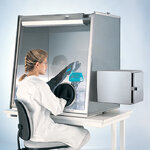neazoi
Advanced Member level 6

Solder fumes behaviour considering, for making a blove box
Hi, I want to make a glove box for soldering inside the house with closed windows and so avoiding the chemicals associated with soldering (solder fumes and lead/lead-free metals on hands).
Initially, I thought of bringing air inside the box, using a tube, from outside and having a second tube to put air out of the box as well. However, this requires opening two holes in the window or in the wall of the house, which I do not want.
So I have thought of making a big glove box without any openings or tubes and leave the solder fumes inside as I solder. Then when I finish soldering, move the glove box outside and open it, so that the trapped fumes can get out. Or alternatively, I could include a simple fan solder fume extractor with carbon filters inside the box.
There may be problems with this approach, such as:
The fumes may stick on the surface of the glove box and reduce it's visibility.
The trapped fumes may stick onto the PCBs of the equipment inside the blove box (eg. temperature controlled iron) and damage them.
That is why, I need to find, how the fumes behave when they are hot and when they cool down?
The only hint I have is a responce of enother member who said:
"Most of the fume produced during soldering will condense when cooled and very little of the smoke will remain once the "fume" gets cooled; either by mixing with cold air or just by getting diluted. A part of the fume will not condense; they have the solvent in the flux paste."
Please help?
Hi, I want to make a glove box for soldering inside the house with closed windows and so avoiding the chemicals associated with soldering (solder fumes and lead/lead-free metals on hands).
Initially, I thought of bringing air inside the box, using a tube, from outside and having a second tube to put air out of the box as well. However, this requires opening two holes in the window or in the wall of the house, which I do not want.
So I have thought of making a big glove box without any openings or tubes and leave the solder fumes inside as I solder. Then when I finish soldering, move the glove box outside and open it, so that the trapped fumes can get out. Or alternatively, I could include a simple fan solder fume extractor with carbon filters inside the box.
There may be problems with this approach, such as:
The fumes may stick on the surface of the glove box and reduce it's visibility.
The trapped fumes may stick onto the PCBs of the equipment inside the blove box (eg. temperature controlled iron) and damage them.
That is why, I need to find, how the fumes behave when they are hot and when they cool down?
The only hint I have is a responce of enother member who said:
"Most of the fume produced during soldering will condense when cooled and very little of the smoke will remain once the "fume" gets cooled; either by mixing with cold air or just by getting diluted. A part of the fume will not condense; they have the solvent in the flux paste."
Please help?
Attachments
Last edited:



